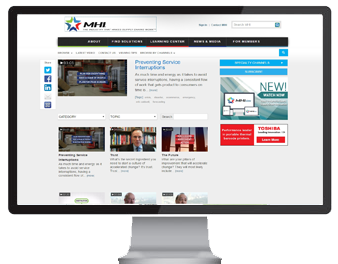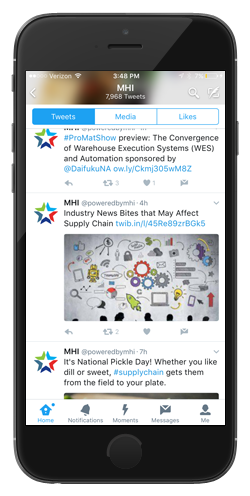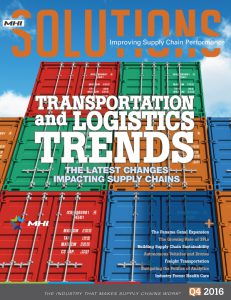From the Corner Office: Carol Miller, MHI

When you have a four-person staff managing the production of a handful of association publications, content marketing for offline and online platforms and event marketing for two 35,000-attendee annual trade shows plus several smaller events, it’s SMART to have a goal-oriented plan of attack.
That’s the main message Association Adviser received from Carol Miller, vice president of marketing & communications at MHI, the nation’s largest material handling and logistics association. MHI’s vision is to be recognized as the authority for material handling and the supply chain industry. Miller and her marketing team create thoughtful goals and content plans to position MHI as the industry’s premier resource for information.
We spent some time talking with Carol about how MHI works toward their team goal of positioning the association as a thought leader within the industry, as well as helping members prepare for what’s coming next for the success of their businesses.
Association Adviser: Tell us about the marketing and communication goals of the MHI.
 Carol Miller: We set our marketing goals based on MHI’s overall association goals: to create awareness of MHI as a resource for members and the end user community — our members’ customers and other non-member participants in the manufacturing and supply chain space — and awareness of the work of the industry as a whole, and to engage with this audience for the improvement of their business and the overall economy. It’s an important, exciting and dynamic industry to work in. We accomplish this through trade events (ProMat and MODEX), conferences, a print and digital magazine (MHI Solutions), an online video portal (MHI View) an annual state-of-the-industry report and remaining active on social media platforms.
Carol Miller: We set our marketing goals based on MHI’s overall association goals: to create awareness of MHI as a resource for members and the end user community — our members’ customers and other non-member participants in the manufacturing and supply chain space — and awareness of the work of the industry as a whole, and to engage with this audience for the improvement of their business and the overall economy. It’s an important, exciting and dynamic industry to work in. We accomplish this through trade events (ProMat and MODEX), conferences, a print and digital magazine (MHI Solutions), an online video portal (MHI View) an annual state-of-the-industry report and remaining active on social media platforms.
We have a business plan for the association and our Board and staff sets our overall association goals. Then I develop marketing goals based on the association’s overall goals. We use the SMART goal model when goal setting. Using this filter to set our goals and objectives helps us ensure we are working toward something that is specific, measurable, action-oriented, realistic and time-based, in addition to in-line with MHI’s mission and vision statements.
AA: What are some differences between marketing/communication when you first started with the MHI, and now?
CM: I started working at MHI in 1992, so as you can imagine marketing and communications were very different then; there was no Internet and no email or social media, so we used more traditional marketing channels like PR, print advertising and direct mail to market events and share news. The main difference in our approach today is the integration of digital marketing tools. Even so, we’ve always relied on an integrated marketing approach so that our audiences can experience the MHI brand in multiple ways. Back in 1992, all our communications were offline but we still diversified our marketing activity through advertising, direct mail and events. Now, we balance traditional approaches with digital ones in an effort to reach our audiences with the right messages, in the way they prefer to receive them.
We’re constantly working to stay up-to-date with all the ways marketers can engage their audiences. We still utilize direct mail because it works for our audience. There is a lot of marketing research out there about how direct mail still works to get attention and convey a message. I think that while digital tools are improving and important, there’s still a place for direct mail, whether it’s a magazine or promotional mailer. It’s just one more way for your audience to interact with your brand. We’ve tried a lot of marketing tools, and with our industrial B2B audience we’ve found that traditional media still has a place with our audience. At the same time, some members prefer digital communications over print. So we strive to provide an integrated communication experience for our audiences that offers both traditional and digital.
AA: Which changes have had the biggest impact on members and the audiences they serve, and why?
CM: The Internet and other digital tools are the biggest factor that has affected marketing. We once had no website, no email; all our communications with members were offline. Our members didn’t have websites or email either. Now, especially with the prevalence of mobile devices and the analytics to measure digital communications usage with, digital has totally changed the way we market and the way we help our members market. That is why we put so much of our marketing efforts on web, social and mobile tools as well as content marketing to create better engagement with the MHI brand.
AA: MHI began its video program, MHI View, in August 2015 and has a robust set of featured topics: everything logistics from cloud computing to wearable technology. What was MHI’s motivation for beginning a video program?

CM: We rebranded MHI in 2012, and one of our goals was to be seen as more of a thought leader in manufacturing and supply chain. As a result, our focus shifted to content marketing. We had the MHI Solutions magazine and the MHI Annual Industry Report, and when Naylor approached us with the idea of a video program it was a great fit because video could complement the content in these resources. We could break up the same information into smaller, digestible chunks and encourage people interested in manufacturing and supply chain issues to get a quick overview of trends and technologies through video, and then take a deeper dive into the topic by visiting MHI.org, reading our magazine, attending our event or contacting our member solution providers to learn more.
We’ve been getting incredible engagement on MHI videos and excellent feedback. We couldn’t be more excited about where the MHI videos have taken us.
AA: What have been some of the best benefits to come out of this video program?
CM: It’s all about engagement. These videos allow MHI to engage with our existing audience and reach out to new people in a creative way. They can easily learn more about us and our members and the solutions they provide. I think this engagement is helping us meet our goal of becoming a thought leader in manufacturing and supply chain because these videos are a springboard for further engagement with the MHI brand.
AA: What have been some drawbacks to producing video?
CM: From a marketing perspective, I don’t see any drawbacks to producing and posting video, but as with all marketing content, you must keep feeding the beast. You’re only as good as your last blog post, magazine issue or video, so there is this constant need to create more and more content. That can represent a challenge when you have limited resources. That’s our only drawback, but it’s more of a challenge than a drawback.
We use good planning tools to meet this challenge. We’ve done more than 50 videos in the past year but we have an extension of our internal team helping us plan and produce them. We create thought-out content calendars at the beginning of the year and a production schedule that we stick with. It’s challenging but rewarding, and seeing people watch and learn from our videos makes the hard work worth the effort.
AA: As communication becomes more social, and sites such as Facebook, Yelp and even YouTube become online gathering spots for people to discuss individuals, brands and companies, what role do you think associations should have in participating and shaping those conversations?

CM: Associations definitely have a role here. They represent their industry and should not just be in the conversation but leading it. And I would like to see associations that represent the same industry get together to lead the conversation better. At MHI, we are taking social media to be more than a conversation — more than just putting out tweets or writing blog posts. If our audience reaches out to us, we continue the conversation.
AA: MHI is active on Twitter, LinkedIn, Facebook and YouTube and hosts its own blog. What does the team that manages this look like? How do you ensure all bases are covered, and covered well?
CM: We have four marketing communications professionals to cover everything — trade shows, conferences, events, the Annual Industry Report, website content, MHI Solutions, MHI View. Its gets a little thin between four people, but during the last two years we’ve dedicated two members of our team to social media outreach. They have other duties, but are primarily responsible for setting strategy, getting approval for that strategy and executing it. Our team and our social media activity can be more focused now with two people than it was when all four of us worked on social in a less coordinated way. We still plan and manage social through content calendars and tools like HootSuite, so we’ve been able to streamline and do more with the same number of people.
We also partner with outside providers like Naylor to add to our bench strength in communications. Those partnerships really helps feed the content monster for social media and our blog that we can repurpose content and extend the conversation in our main communication channels.
AA: What kind of feedback do you get from members about your publications?

CM: We conduct an annual research reader feedback project about the quality of our publications and we’ve been getting excellent ratings. Our members seem to be very engaged with MHI Solutions. The magazine goes to members and their customers, who often attend MODEX. We get good feedback about the opportunity MHI Solutions gives them to get their business message out via advertising, and they enjoy the chance to stay up-to-date about trends and news in the industry through the magazine’s editorial content. I think our magazine focuses differently on the same issues than other industry publications cover. MHI Solutions is a quarterly publication, which gives us more time to write articles about singular issues in more depth. This production schedule gives us the ability to thoroughly analyze what our audience needs to know today to be able to operate more efficiently tomorrow.
Our surveys have told us that readers appreciate the detail as well as the overall view of what’s coming next in our industry. This approach feeds back into our thought leadership goal. Our members and customers need someone to say, “We’re here to give you a 30,000-foot view of what’s happening next in manufacturing and supply chain while also helping you focus on issues of concern today.”
AA: What are some communications initiatives you would like to launch in the coming year?
CM: More marketing automation and more marketing analytics. We want to provide our audiences with a more custom experience from MHI. We do a little of this customization already, but this area of marketing is changing so fast, and we want to remain relevant to our audiences. So we’re looking for new ways we can slice and dice our data and use the analytics from our digital communications to improve the audience experience with our brand.
We use Google Analytics and other products to manage our communications at the moment. We use iMIS as our customer relationship management system and we’re looking at some of their marketing automation options, as well as other products that can help us implement a more customized, personalized marketing experience for our members and all audiences. It’s all about tailoring their experience so that we remain true to our goals and our vision of being the premier authority for a material handling industry that enhances how supply chains work.

